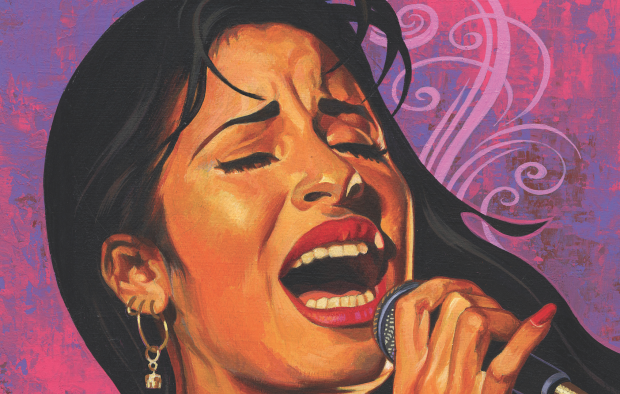Mateo Gonzales presses play and the track springs to life. The window on his laptop shows various layers of composition scrolling by. There’s a sample of Bobby Day’s “Rockin’ Robin.” The trilling whistle of the early rockabilly hit leaps from the small computer speakers, as do the more tinny rhythmic elements: the high hats and snare of a boom-bap beat are clearly audible, as is the scratchy güira, which plays a consistent shuffle. Less audible is the slouching bass that will ultimately help punch-up the song when Gonzales plays it for a crowd on a dancefloor with a decent subwoofer.
With this mashup, Gonzales, who makes music as Philthy Dronez, has pulled together three genres of music to produce a fourth. Sometimes called “cumbia bass,” the style owes no small debt to the inclusion of the güira—the colander-like percussion instrument that is played by scraping a spoon or stick along a corrugated metal cylinder. It’s a familiar sound for those who grew up in the South Bay.
Cumbia, a traditional form of Latin dance music, is a part of the sonic fabric of just about every country south of the Rio Grande. From Mexico and the Caribbean through Colombia—the genre’s country of origin—on down to Argentina, cumbia has been moving people for generations. While cumbia bass music is comprised of many long-extant sounds and musical styles, it’s new to the U.S., according to a number of tastemaking DJs and musicians who are actively producing the tropically inflected style in San Jose.
Here, in the cultural melting pot that is Silicon Valley, a generation of Latin-American musicians, like Gonzales, are helping to spread the sound through mashups, DJ sets and bands informed by the music of their ancestors, as well as what they grew up hearing on KMEL 106.1, Live 105 and Wild 94.9.
Two Worlds
There’s an expression, Gonzales says: “Sus pies en dos lados.” Literally translated, “Your feet on both sides.”
In this context, it means being a part of two cultures at the same time. Growing up, he explains, cumbia was everywhere. He heard it at home, at parties and on TV every time Selena came on. Banda, mariachi and corridos were also inescapable.
But growing up in San Jose, hip-hop, punk, R&B, rock & roll and soul were also ubiquitous. So was DJ culture. That Gonzales would ultimately seek to blend it all together may have been inevitable. Just ask Fernando J. Pérez and Roman Zepeda. Two of the founding members of local Latino party-production collective Sonido Clash, the pair understand where Gonzales is coming from.
“Being Mexican-American you’ve got one foot on one side and the other foot on the other side,” Pérez says, echoing Gonzales. “We’re not from here, we’re not from there—so what are we?”
It’s a question that can lead to a very specific anxiety—which actor Edward James Olmos summed up so succinctly playing Abraham Quintanilla in the 1997 biopic of ’90s Mexican-American pop icon Selena: “I mean, we gotta know about John Wayne and Pedro Infante,” Quintanilla says, bemoaning his dual identity’s burden. “We gotta know about Frank Sinatra and Agustín Lara.” He goes on to lament how “exhausting” it can be attempting to be “more Mexican than the Mexicans and more American than the Americans.”
Whether this philosophical stance was imprinted on the young Selena Quintanilla explicitly, or whether the scene was the product of the writers room, it’s abundantly clear that the singer and her band sought to incorporate two worlds into their music. The same can be said for the music and events curated by Sonido Clash. Most recently, Sonido Clash threw a party in celebration of the late Selena’s 46th birthday. The sold-out bash at Back Bar in San Jose featured a lookalike contest, music from a local cumbia band and multiple Latin-inflected DJ sets.


Although the events Pérez and Zepeda produce with their partners—Thomas Aguilar, Angel Luna and Quynh-Mai Nguyen—all tend to have a dance and hip-hop bent, the influences extend to other avenues of culture. Over the course of an hour-long conversation, Pérez and Zepeda bounce around from the San Jose-based founder of Lowrider Magazine to local gutter punk and powerviolence acts. They reminisce about hunting for obscure music at the Berryessa Flea Market, spinning freestyle at house parties and listening to Los Tigres Del Norte in their childhood homes.
Pérez and Zepeda have been drawn to different sounds, from punk and metal to funk and soul. However, of late, Zepeda says, the music he makes under his DJ moniker Turbo Sonidero, and as a member of Corazón Salvaje, there is one constant—cumbia.
“I was playing punk before,” Zepeda says. “I was doing hip-hop beats and rap beats and one day, I was like, ‘I wanna make people dance.’” By incorporating a cumbia beat into his productions, he was able to find a middle ground between his family’s home state of Puebla, Mexico, and his home in San Jose. Recently, he and fellow Sonido Clash affiliate Luna—a.k.a. the emcee Mextape—put out a collaborative project, Vatos, under the moniker Turbomex. On the full-length album, Mextape spits rhymes mostly in Spanish, with some English and Spanglish mixed in, while Turbo Sonidero handles production. Listen to the project and it won’t take long for you to hear the güira, chk-chking away.
Cumbia Punks: Corazón Salvaje | Cinco De Mayo Guide



